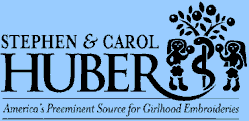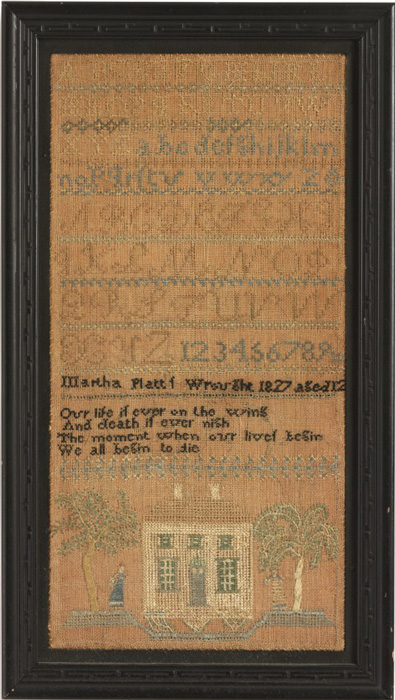|
|
|
|
Lot Number: 280-2 (description taken from Sotheby's catalogue) NEEDLEWORK SAMPLERS: MARTHA PLATT (1815-1887) The first by Martha Platt, Milford, Conneticut, dated 1827, worked with silk threads on linen in eyelet, satin, buttonhole, outline, long and short, and cross-stitches. Inscribed: Martha Platt s Wrought 1827 aged 12. 16 1/2 by 8 inches; (22 threads to the inch); Sothby's estimate: $8,750 - $11,500 (for lots 280-1, 2, 3) combined with 25% buyer's premium added) Sold (SPECIAL SALES PRICE - no
buyers premium) (To purchase call 860-388-6809)
Catalogue Note: The residents of Milford, Connecticut, which is situated on the Wepawaug River, along Long Island Sound, showed
little concern for public education during the first few decades of the nineteenth century, depending instead on
schooling by private means for those who could afford to pay. l An attempt was made in 1824 to hire Betsey Fowler
of Ship Yard Lane at "8 1/2 [dollars?]" a month (it is not known whether she accepted the offer). In
1836, schoolmistress Alma L. Williams billed Mr. Ford 14 1/2 cents a week to educate his daughter, Elizabeth. The
amount for an eight-week term was $1.16.2 While it is known that private schools for girls were available in Milford,
many parents sent their daughters to be educated in more fashionable New Haven boarding schools. The long history
of schooling in New Haven begins in 1651, with the dame school kept by Goodwife Wickham.3 Martha Platt may have
studied needlework and ornamental embroidery in New Haven, for her sampler bears a certain similarity to a sampler
worked by Lydia Church in 1791, at Mary Mansfield's New Haven school. Mansfield, who taught at least from 1791
to 1793, may have been responsible for the initial sampler design, which was then continued by another teacher.4
Martha's unbordered sampler displays a modest, and for the period straightforward, version of the central portion
of that stitched by Lydia Church, which is lavishly embellished with a wide, solidly embroidered black border.
Like Lydia, however, Martha has worked similarly branched trees, a house with two of the windows divided into twelve
panes, a pedimented door pierced by two glazed inserts, a garden of flowers, and sprightly costumed figures.5 Although
verging on the ordinary, Martha's sampler has been adorned with two of the most enchanting figures in American
sampler embroidery. Each figure, meticulously endowed with human hair, holds a tiny nosegay of flowers. The figure
to the left wears a fashionable blue, tent-stitched dress, scrupulously trimmed with pale ivory silk, while the
figure at the right wears a dress with a soft blue bodice and a biscuit-colored skirt, worked entirely in horizontal
bands of buttonhole stitches. This unusual method of depicting a particular style of fashion-with thread, needle,
and a minimum number of stitches-is technically extremely difficult. But Martha Platt succeeded in achieving graceful,
properly proportioned figures and, most important, has created the effect of finely pleated, or gathered, tiers
of fabric in one of the costumes. The very smallest of neatly worked slippers may be detected at the hemline of
each dress. Fancy needlework of the first and second quarters of the nineteenth century sometimes lacks a certain
sophistication when compared to the fine examples taught by earlier, more demanding schoolmistresses. The rage
for ornamental embroidery in schools for girls was diminishing by the middle of the century, to be supplanted by
special classes in painting, drawing, and music. Thus an acceptance of greater simplicity in needlework may explain
the missing border on Martha Platt's sampler, though her delightful sampler figures remain unsurpassed. Born in
Milford on October 28, 1815, to Nathan Platt and Sarah Fowler, Martha was the youngest of four children. Her family
was among the first to settle in New Haven in the first half of the seventeenth century.6 The house in which Martha
lived still remains on old East Town Street. Built in 1823, it was occupied by members of the Platt family for
over 150 years.7 Sometime before 1841; Martha Platt married De Luzerne Hubbell. They lived in a large white house
on Clark Street in Milford. They had no children. Martha Platt Hubbell died April 26, 1887, and is buried in the
Milford Center Cemetery.8 Exhibited and Literature: LACMA, Martha Platt, pp. 91-92, fig. 38.
STEPHEN & CAROL HUBER |


